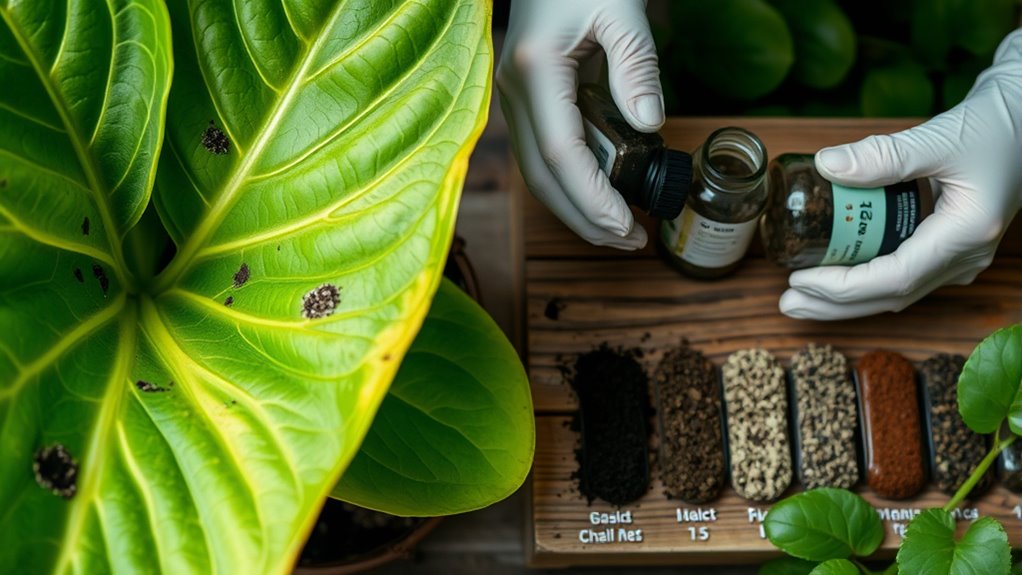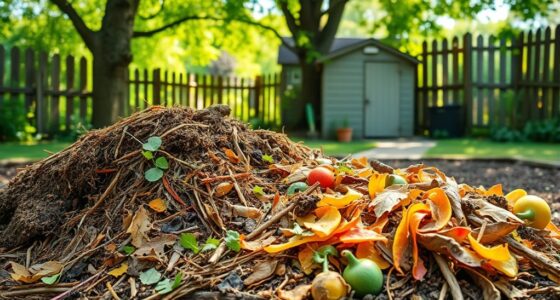To identify and treat plant nutrient deficiencies, watch for visual symptoms like yellowing leaves or stunted growth. Conduct soil tests to check nutrient content and pH levels. For treatment, use nitrogen-rich fertilizers for nitrogen deficiency, phosphorus-based ones for phosphorus issues, and potassium-rich options for potassium needs. Incorporating organic matter can also help. By understanding these essentials, you'll improve your plants' health and discover further insights into effective nutrition management.
Key Takeaways
- Observe visual symptoms like yellowing leaves or stunted growth to identify potential nutrient deficiencies in plants.
- Conduct soil and leaf testing to analyze nutrient levels, pH, and diagnose specific deficiencies.
- Apply appropriate fertilizers, such as nitrogen-rich or phosphorus-based, to treat identified nutrient deficiencies effectively.
- Maintain proper soil pH between 6.0 and 7.0 to enhance nutrient availability and uptake for healthy plant growth.
- Regularly monitor nutrient levels through testing and incorporate organic matter to prevent future deficiencies.
Understanding Nutrient Deficiencies in Plants
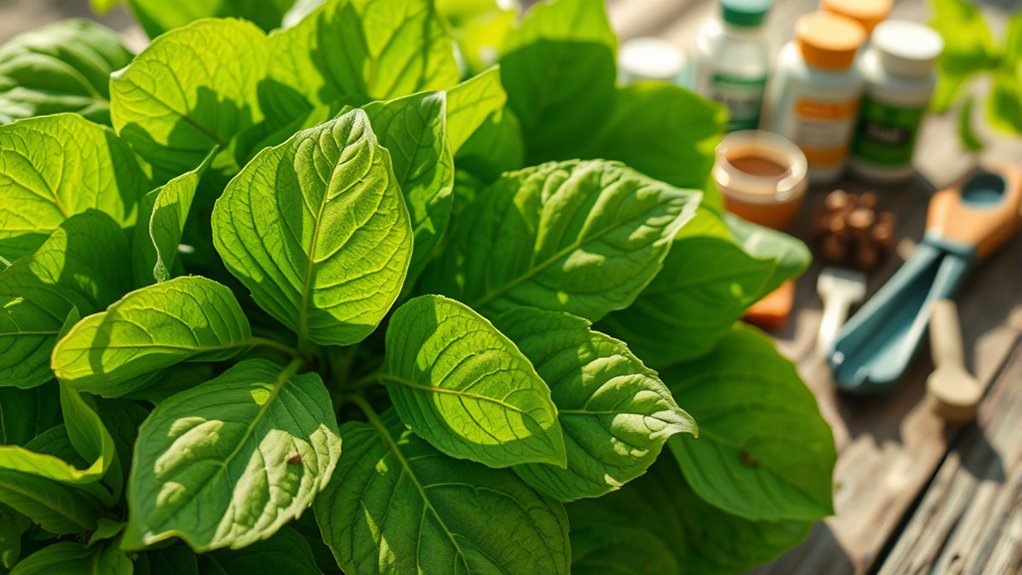
Have you ever wondered why your plants might be struggling despite your best efforts? It could be due to nutrient deficiencies.
When plants lack essential soil nutrients like nitrogen, phosphorus, or potassium, they exhibit symptoms like stunted growth and chlorosis, which is the yellowing of leaves. These deficiencies can arise even in seemingly nutrient-rich soils, influenced by factors like soil pH and moisture levels.
Each nutrient deficiency presents unique signs; for example, older leaves turning yellow often points to a nitrogen lack. Understanding these symptoms is vital for maintaining your plants' health, as untreated deficiencies can severely impact flowering, fruiting, and overall productivity.
Recognizing these issues early can help you take effective action for thriving plants.
Identifying Nutrient Deficiencies in Plants
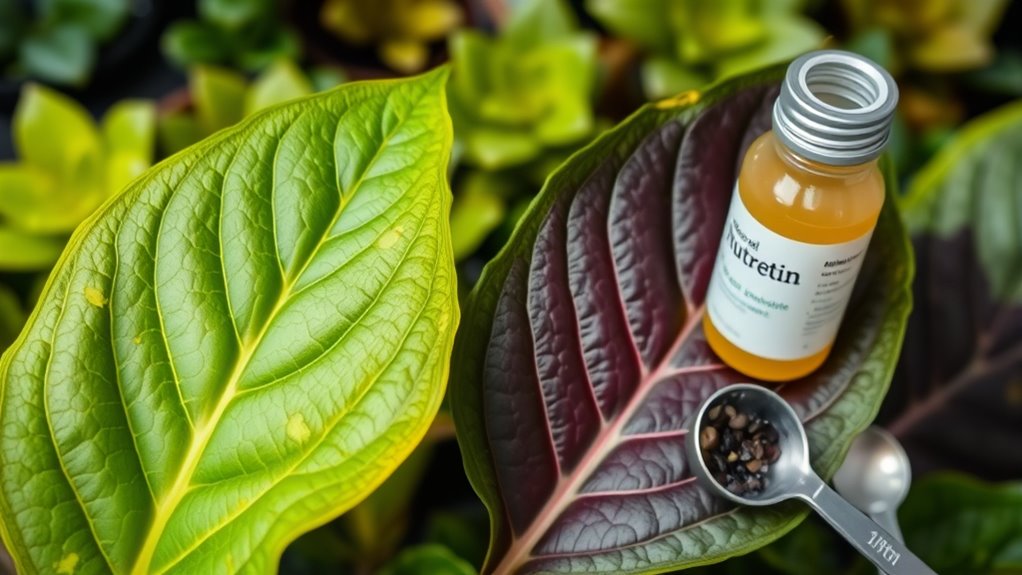
You can spot nutrient deficiencies in your plants by observing visual symptoms like yellowing leaves or stunted growth.
Soil and leaf testing can confirm your suspicions by providing detailed information on nutrient levels.
Understanding nutrient mobility patterns will also help you identify which deficiencies are affecting your plants.
Visual Symptoms of Deficiencies
Understanding the visual symptoms of nutrient deficiencies in plants is vital for maintaining their health and productivity.
For instance, yellowing leaves often indicate a nitrogen deficiency, where older leaves yellow while new growth remains pale green.
Phosphorus deficiency manifests as dark green or reddish-purple older leaves, coupled with slow growth and brown spots.
If you notice scorched leaf edges and chlorosis between veins, you're likely dealing with potassium deficiency, which can stunt flowering and fruiting.
Magnesium deficiency is marked by interveinal chlorosis on older leaves, showing yellow patches between veins.
Finally, iron deficiency appears as interveinal chlorosis in younger leaves, where the tissue pales while the veins stay dark green.
Recognizing these nutrient deficiency symptoms is essential for timely intervention.
Soil and Leaf Testing
Recognizing visual symptoms of nutrient deficiencies in plants is just the beginning of effective plant care. To truly understand your plants' needs, you should engage in soil and leaf testing. Soil testing analyzes soil samples for nutrient content, pH, and electrical conductivity, while leaf testing measures nutrient concentrations in plant tissues. These methods help confirm deficiencies and optimize plant nutrition. Additionally, regular testing can prevent nutrient imbalances, similar to how monitoring for signs of distress is crucial in caring for pregnant goats.
| Testing Type | Purpose | Timing |
|---|---|---|
| Soil Testing | Identify nutrient content | Before planting or during growth |
| Leaf Testing | Confirm visual deficiencies | Different growth stages |
| Both | Adjust fertilization strategies | Regular intervals |
| Regular | Prevent nutrient imbalances | Enhance plant health |
Together, these tests allow for targeted actions to enhance plant health.
Nutrient Mobility Patterns
While diagnosing nutrient deficiencies in plants can be challenging, knowing how nutrients move within the plant can simplify the process.
Here's a quick guide to nutrient mobility patterns and their related deficiency symptoms:
- Nitrogen: Highly mobile; older leaves show yellowing and stunted growth.
- Phosphorus: Mobile; dark green or reddish-purple older leaves indicate a deficiency.
- Potassium: Mobile; scorched edges on older leaves signal a lack of this nutrient.
- Calcium: Less mobile; deficiency symptoms appear in young leaves, often leading to chlorosis.
Understanding these patterns helps you accurately identify nutrient imbalances and micronutrient deficiencies, ultimately supporting better plant health. Additionally, incorporating self-watering planters can help maintain consistent moisture levels, further promoting nutrient uptake.
Common Symptoms of Nutrient Deficiencies
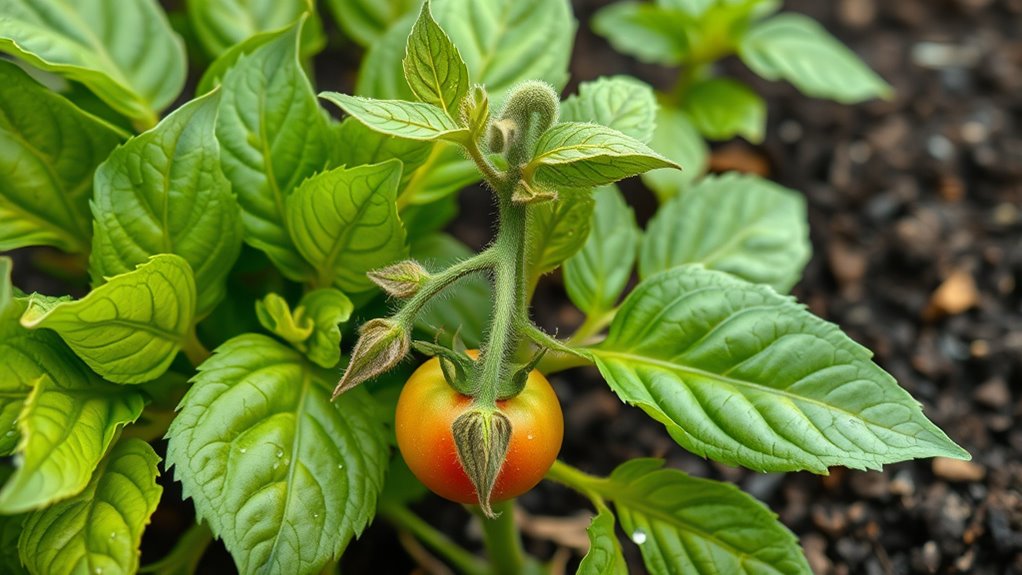
Nutrient deficiencies can considerably impact plant health, often revealing themselves through distinct symptoms.
For instance, nitrogen deficiency typically shows as yellowing of older leaves and weak growth, sometimes with purple stripes on stems.
Phosphorus deficiency might present dark green or reddish-purple leaves, stunted growth, and leaf tip necrosis.
Phosphorus deficiency can lead to dark green or reddish-purple leaves, stunted growth, and necrosis at the leaf tips.
If you notice brown or burnt edges on leaves along with yellowing between veins, potassium deficiency could be the culprit.
Magnesium deficiency often leads to chlorosis between veins on older leaves, while untreated cases may result in necrosis.
Finally, iron deficiency manifests as interveinal chlorosis in younger leaves, with darker veins contrasting against pale tissue.
Recognizing these symptoms of nutrient deficiency is essential for maintaining ideal plant health.
The Role of Macronutrients in Plant Health
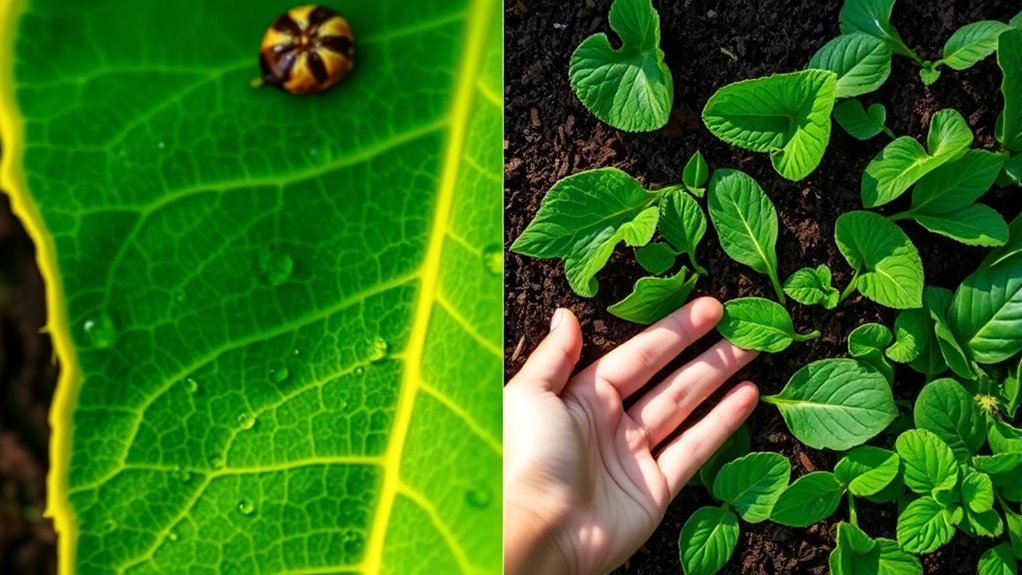
Macronutrients are crucial for your plants' health, impacting everything from growth to photosynthesis.
When you notice symptoms like yellowing leaves or poor flowering, it could signal a deficiency in these essential nutrients.
Understanding their roles and how to treat deficiencies can help you keep your plants thriving.
Essential Macronutrients Explained
Understanding the essential macronutrients is key to maintaining healthy plants, as they play critical roles in growth and development.
Here's a quick overview of the primary macronutrients:
- Nitrogen: Crucial for protein and chlorophyll formation; deficiency leads to yellowing leaves.
- Phosphorus: Supports root development and energy transfer; lack of it causes dark green leaves with purple hues.
- Potassium: Regulates water uptake and enzyme activation; deficiency results in scorched leaf edges and poor flowering.
- Calcium: Fundamental for cell wall structure; deficiency can cause stunted growth and blossom end rot.
Keeping an eye on soil nutrient levels helps prevent nutrient deficiencies, ensuring robust plant growth and overall vitality. Additionally, understanding color accuracy can enhance the visual appeal of your garden by ensuring vibrant plant colors.
Symptoms of Deficiencies
While cultivating a thriving garden, being aware of deficiency symptoms can save your plants from significant stress.
Nitrogen deficiency shows as yellowing of the oldest leaves and slow growth, impacting your plant's health.
Phosphorus deficiency may lead to dark green or reddish-purple leaves, signaling energy transfer issues.
For potassium, look for browning or burning at leaf edges and chlorosis between leaf veins, which affects water regulation.
Calcium deficiency results in stunted new growth and tip burn, while magnesium deficiency presents as interveinal chlorosis in older leaves.
Recognizing these symptoms of nutrient deficiencies early can help maintain a healthy plant and prevent further damage.
Keep an eye on your plants to guarantee they thrive and flourish!
Treatment and Solutions
To guarantee your plants thrive, addressing nutrient deficiencies with the right treatments is essential.
Here's how you can tackle common issues:
- Nitrogen Deficiency: Boost leafy growth by applying nitrogen-rich fertilizers or foliar spray.
- Phosphorus Deficiency: Stimulate root development with phosphorus amendments to enhance energy transfer.
- Potassium Deficiency: Improve flowering and prevent browning edges by using potassium-rich fertilizers.
- Calcium and Magnesium Deficiencies: Combat stunted growth and blossom end rot by applying calcium-rich soil amendments like lime or gypsum, and treat magnesium deficiency with Epsom salts.
The Role of Micronutrients in Plant Health
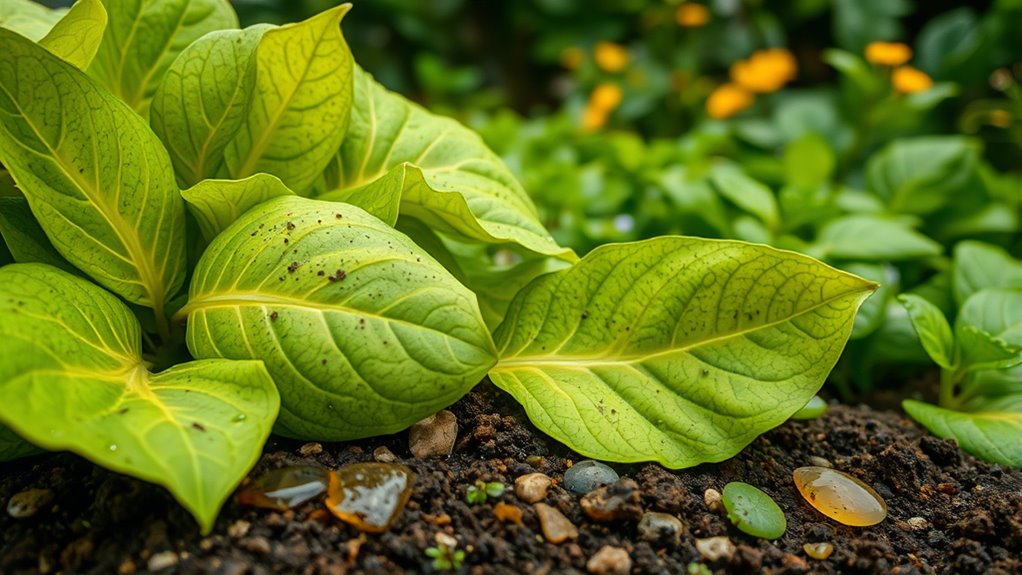
Micronutrients, though required in smaller quantities than macronutrients, play an essential role in your plants' health and overall growth.
Iron, for example, is critical for chlorophyll production, and a deficiency can lead to interveinal chlorosis in young leaves.
Iron is vital for chlorophyll production; a deficiency can cause interveinal chlorosis in young leaves.
Zinc supports enzyme function and growth regulation; without it, you might notice stunted growth and chlorosis, especially in sandy soils.
Boron is essential for cell wall structure and reproductive development, with its absence causing stunted growth and deformed tissues.
Molybdenum aids in nitrogen fixation, and a lack of it can result in yellowing and mottled leaves, particularly in older plants.
Understanding these micronutrients helps you prevent nutrient deficiencies and maintain ideal plant health.
Causes of Nutrient Deficiencies
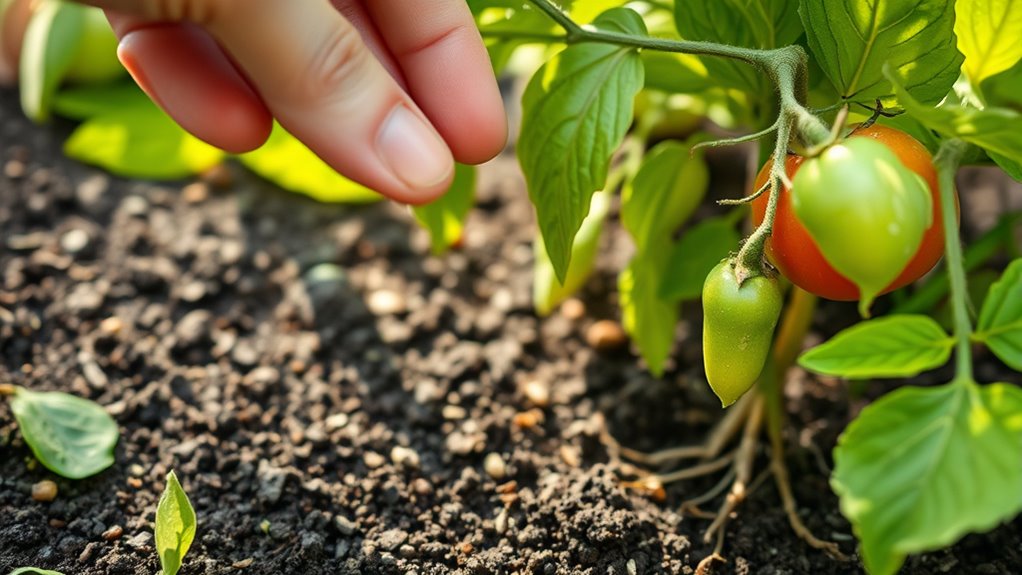
Nutrient deficiencies can stem from a variety of causes that you might encounter in your gardening efforts.
Poor soil quality and imbalanced nutrient levels can prevent your plants from accessing the essential elements they need.
Additionally, environmental stress factors like drought or waterlogging can further complicate nutrient uptake, leaving your plants struggling to thrive.
Soil Nutrient Imbalance
When it comes to soil nutrient imbalances, several factors can contribute to deficiencies that hinder plant growth. Understanding these causes can help you address nutrient deficiency in plants effectively:
- Low organic matter content – Reduces nutrient-holding capacity and decreases nutrient availability for plant uptake.
- pH levels – Acidic soils (pH below 6) limit essential nutrients like phosphorus and calcium.
- Leaching – Excessive rainfall or irrigation washes away crucial nutrients, leading to deficiencies.
- Nutrient competition – In densely planted areas, some plants absorb more nutrients, leaving others deficient.
Additionally, soil salinization can create toxic conditions, impeding nutrient uptake despite their presence.
Addressing these issues will help improve your soil's health and enhance plant growth.
Environmental Stress Factors
While various soil conditions play a role in nutrient availability, environmental stress factors greatly impact plant health and growth.
Soil pH imbalances can hinder nutrient absorption, with acidic soils limiting phosphorus uptake and alkaline soils restricting micronutrients.
Water stress, whether from drought or waterlogging, impedes roots' ability to absorb nutrients, leading to deficiencies.
Additionally, soil salinization can create osmotic stress, further reducing nutrient absorption.
Extreme temperatures also disrupt metabolic processes, increasing potassium demands while limiting its uptake.
Finally, poor soil structure and compaction restrict root growth, making it tough for plants to access essential nutrients.
Treatment Solutions for Nutrient Deficiencies
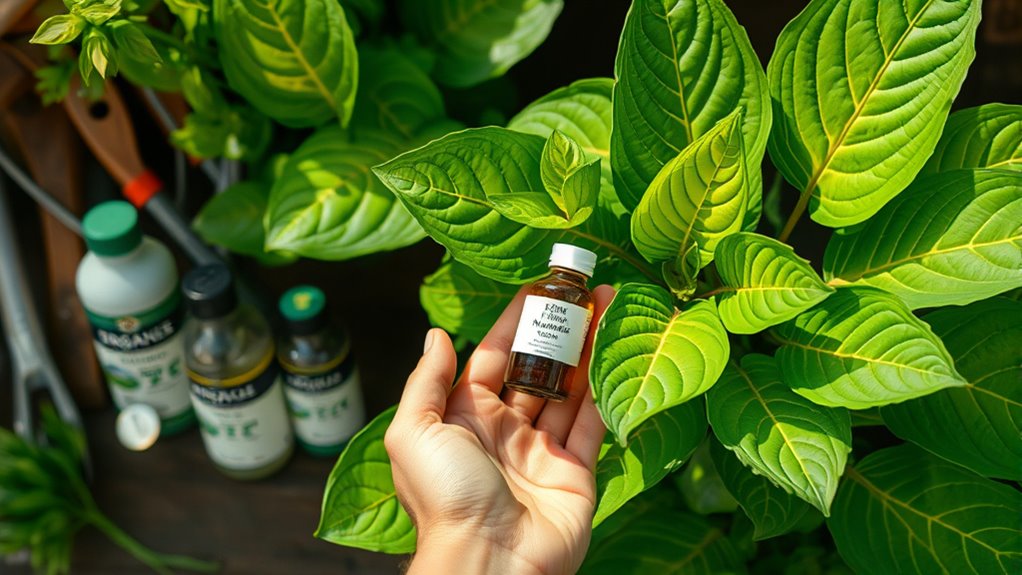
To effectively address nutrient deficiencies in plants, you'll want to apply specific treatments tailored to each deficiency type. Here are some treatment solutions you can use:
Addressing nutrient deficiencies in plants requires tailored treatments for each specific type, ensuring optimal growth and health.
- Nitrogen deficiency: Apply nitrogen-rich fertilizers like ammonium sulfate or organic mulches to promote leafy growth.
- Phosphorus deficiency: Use phosphorus-specific fertilizers such as superphosphate or bone meal to enhance root development.
- Potassium deficiency: Apply potassium-rich fertilizers like sulfate of potash, improving water regulation and flowering.
- Magnesium deficiency: Remedy it with Epsom salts as a foliar spray or soil additive to boost chlorophyll production.
For micronutrient deficiencies, targeted treatments like iron sulfate or manganese sulfate can help guarantee proper leaf development and photosynthesis, keeping your plants healthy and thriving.
Preventing Nutrient Deficiencies
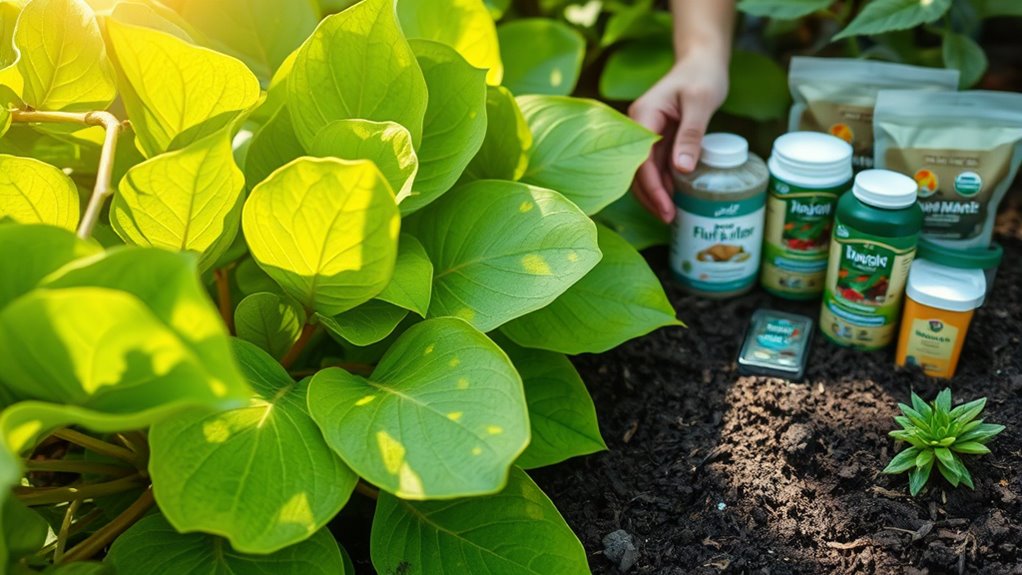
Preventing nutrient deficiencies in your plants starts with proactive measures that guarantee they have access to essential nutrients throughout their growth. Regularly test soil and plant tissue to monitor nutrient levels and adjust your fertilization practices as necessary. Maintaining proper soil pH, ideally between 6.0 and 7.0, is vital for nutrient availability. Incorporate organic matter and mulch to improve nutrient retention, enhance microbial activity, and promote soil health. Use balanced fertilizers tailored to specific nutrient needs during different growth stages. Additionally, implement crop rotation to diversify planting, reduce pest pressures, and maintain a balanced nutrient profile. Consistently applying integrated pest management techniques can also help ensure that your plants remain healthy and nutrient-rich.
| Action | Purpose |
|---|---|
| Test Soil | Monitor nutrient levels |
| Maintain pH | Guarantee nutrient availability |
| Add Organic Matter | Improve soil structure |
| Use Balanced Fertilizers | Support plant health |
Measuring Soil Ph, EC, and Temperature

Understanding the importance of soil pH, electrical conductivity (EC), and temperature is essential for maximizing plant health and nutrient uptake.
Regular soil testing can help you identify imbalances that lead to nutrient deficiencies. Here's what to measure:
- Soil pH: Affects nutrient solubility; aim for 6-7 for ideal nutrient availability.
- Electrical Conductivity (EC): Indicates salinity; high levels can hinder nutrient absorption.
- Soil Temperature: Ideal range is 60°F to 75°F (15°C to 24°C) for healthy root development.
- Nutrient Deficiencies: Monitor to guarantee sufficient micronutrients like iron and zinc, especially in high pH soils.
Utilizing Technology for Nutrient Management

As farmers face the challenges of nutrient management, utilizing technology can greatly enhance the efficiency and effectiveness of their practices.
Satellite technologies like EOSDA Crop Monitoring use vegetation indices to detect crop stress, helping you identify potential nutrient deficiencies across large areas without extensive field inspections. Remote sensing data offers real-time insights into plant health, allowing you to monitor changes in nutrient levels over time.
Utilizing satellite technologies like EOSDA Crop Monitoring enables efficient detection of crop stress and nutrient deficiencies across vast fields.
Soil testing technologies, including portable sensors, enable precise measurement of nutrient concentrations and pH levels. By employing precision agriculture tools, such as variable rate technology, you can apply specific nutrient treatments based on localized soil conditions.
Integrating weather data optimizes fertilizer application timing, reducing leaching and maximizing crop uptake efficiency for better yields.
Frequently Asked Questions
How Do You Identify and Correct Plant Nutrient Deficiencies?
To identify and correct plant nutrient deficiencies, start by observing your plants for specific symptoms. Yellowing leaves might indicate nitrogen issues, while dark green or purplish hues could signal phosphorus deficiencies.
Conduct soil tests to check nutrient levels and pH. Once you pinpoint the deficiency, apply the appropriate fertilizers, like high-nitrogen for nitrogen issues.
Don't forget to take into account environmental factors that might affect nutrient uptake, ensuring your plants get what they need to thrive.
How Do You Detect Nutritional Deficiencies?
You can detect nutritional deficiencies by observing your plants closely, checking for yellowing leaves, stunted growth, or malformations.
You should also conduct soil tests to analyze nutrient levels and pH. Keep an eye on fast-growing and older leaves, as changes here often signal issues.
Additionally, using remote monitoring technologies can help you identify crop stress and potential deficiencies early.
Regular assessments will guarantee your plants stay healthy and productive.
How Do You Diagnose Plant Deficiencies?
To diagnose plant deficiencies, you'll start with a close visual inspection.
Look for symptoms like yellowing leaves or stunted growth, which can signal specific nutrient issues.
Soil testing is essential; it helps you analyze nutrient levels and pH.
Keep an eye on the plant's growth stage and environmental factors, as these influence nutrient needs.
Using monitoring technologies can also help spot early signs of nutrient stress before they escalate.
What Are the 3 Most Common Nutrient Deficiencies in Plants?
Imagine your plants whispering their needs to you. The three most common nutrient deficiencies you'll encounter are nitrogen, phosphorus, and potassium.
When nitrogen's lacking, older leaves turn yellow and growth stalls.
Phosphorus deficiency reveals itself through dark green or purplish leaves and slow development.
Finally, potassium deficiency shows burnt leaf edges and poor flowering.
Recognizing these signs can lead you to healthier, thriving plants, ready to flourish in your garden.
Conclusion
In the garden of life, just like in your plants, balance is key. By identifying and treating nutrient deficiencies, you're not only nurturing your plants but also cultivating resilience in your green companions. Remember, even the mightiest oak started as a small acorn, needing just the right care to grow. So, keep an eye on your plants and embrace the art of nutrient management; it's the secret to transforming a struggling garden into a thriving paradise.

